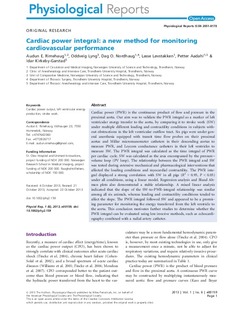Cardiac power integral: a new method for monitoring cardiovascular performance
Rimehaug, Audun Eskeland; Lyng, Oddveig; Nordhaug, Dag Ole; Løvstakken, Lasse; Aadahl, Petter; Kirkeby-Garstad, Idar
Abstract
Cardiac power (PWR) is the continuous product of flow and pressure in the
proximal aorta. Our aim was to validate the PWR integral as a marker of left
ventricular energy transfer to the aorta, by comparing it to stroke work (SW)
under multiple different loading and contractility conditions in subjects without
obstructions in the left ventricular outflow tract. Six pigs were under general
anesthesia equipped with transit time flow probes on their proximal
aortas and Millar micromanometer catheters in their descending aortas to
measure PWR, and Leycom conductance catheters in their left ventricles to
measure SW. The PWR integral was calculated as the time integral of PWR
per cardiac cycle. SW was calculated as the area encompassed by the pressure–
volume loop (PV loop). The relationship between the PWR integral and SW
was tested during extensive mechanical and pharmacological interventions that
affected the loading conditions and myocardial contractility. The PWR integral
displayed a strong correlation with SW in all pigs (R2 > 0.95, P < 0.05)
under all conditions, using a linear model. Regression analysis and Bland Altman
plots also demonstrated a stable relationship. A mixed linear analysis
indicated that the slope of the SW-to-PWR-integral relationship was similar
among all six animals, whereas loading and contractility conditions tended to
affect the slope. The PWR integral followed SW and appeared to be a promising
parameter for monitoring the energy transferred from the left ventricle to
the aorta. This conclusion motivates further studies to determine whether the
PWR integral can be evaluated using less invasive methods, such as echocardiography
combined with a radial artery catheter.
